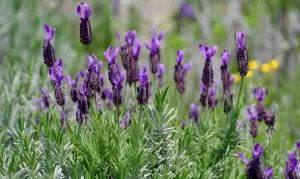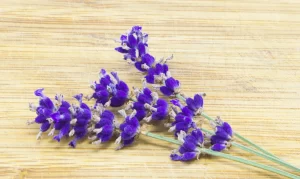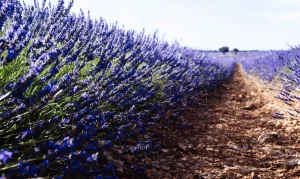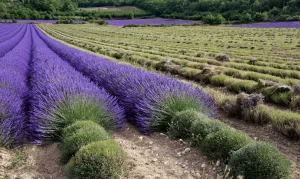How To Start A Lavender Farm? This beautiful crop is sought after by florists, culinary professionals, cosmetic companies, and herbal-medicinal practitioners, so it can be a lucrative crop for your farm.
If you’ve ever been captivated by the scent and sight of a field of lavender in full bloom in midsummer and thought to yourself, “I want to start a lavender farm,” you’re not alone. This vine, which is related to mint, is not as easy to grow as its cousin. Lavender has specific growing, harvesting, and storage requirements, making commercially growing lavender a focused—yet rewarding—adventure.
Contents
- Choose Your Lavender Species
- English Lavender (Lavandula Augustifolia)
- Spanish Lavender (Lavandula stoechas)
- French Lavender (Lavandula dentata)
- Wooly Lavender (Lavandula lanata)
- Spike Lavender (Lavandula latifolia)
- Lavandin (L. hybrida, L. x intermedia)
- How To Start A Lavender Farm? Lavender Cultivation
- Climate
- Propagation
- Planting
- Soil Needs
- Mulching
- Irrigation
- Overwintering
- Harvesting Lavender
- Preserving, Storing, and Drying Lavender
- Lavender Oil: To Make Or Not?
- How To Make Money Growing Lavender?
- Frequently Answered Questions
- Can Lavender Survive The Winter?
- Can I Grow Lavender In Containers?
- What Are Some Blue Varieties Of Lavender?
- How Quickly Does Lavender Grow?
- Conclusion: How To Start A Lavender Farm?
Choose Your Lavender Species
When you first start lavender farming, you will be shocked by the number of lavender varieties available.
- There are over 20 species, each with many varieties.
- The majority have the signature purple buds, but there is also pink lavender, red lavender, and white lavender, giving small-scale lavender farmers more choices.
- Lavender plants of all types will produce for 10 to 20 years if they are safe.
Here are some lavender varieties to remember if you want to start farming lavender:
English Lavender (Lavandula Augustifolia)
- This is the most commonly grown lavender species, and it is a perennial in USDA zones 5B through 8.
- It is used in the manufacture of dried flowers, fragrances (as in oils and perfumes), and flavoring.
- Most plants are 2 to 3 feet tall, according to the University of Florida Institute of Food and Agricultural Sciences Extension Service.
- English lavender varieties include Buena Vista, Munstead, and Hidcote.
Spanish Lavender (Lavandula stoechas)
- Tiara, Blueberry, and Hazel are examples of this genus, and they have flower petals that resemble helicopter blades emerging from the top of the flower pod.
- These are also used in the processing of dried flowers and are cultivated as annuals.
French Lavender (Lavandula dentata)
- These big plants have rosemary-scented buds and leaves that are “fringed” or serrated.
- They thrive in mild, temperate climates and are commonly grown as annuals in the United States.
Wooly Lavender (Lavandula lanata)
- This variety, also known as Spanish Mountain lavender, has a heavy balsam-lavender fragrance and is commonly grown for potpourri.
- It can grow to be 2 to 3 feet tall.
Spike Lavender (Lavandula latifolia)
- According to the North Carolina State University Cooperative Extension, this is the lavender form grown for its essential oil, especially for soaps, but it is rarely grown in the United States due to its Mediterranean climate requirements.
- It can reach a height of 3 feet and spread out.
Lavandin (L. hybrida, L. x intermedia)
- This lavender, also known as Dutch lavender, is a cross between Lavandula angustifolia and Lavandula latifolia.
- These 2- to 3-foot-tall and -large plants bloom only once in late summer, but they produce more flowers and oils than English lavender, though the oils are not always of high quality.
- Since lavender buds fall off the stems, these varieties do not make decent dried-flower lavenders.
- According to Colorado State University Extension, since lavender produces sterile seeds, it can only be replicated by cuttings.
- Among the varieties to be aware of are Grosso, Provence, and Silver Frost.
Read more about Best Palm Tree for Indoors?
How To Start A Lavender Farm? Lavender Cultivation
-
Climate
Lavender thrives in hot, dry, sunny climates as a Mediterranean herb. Many active lavender farms in the United States are situated along with large bodies of water, such as lakes, which have their own warm microclimates.
-
Propagation
Lavender is difficult to grow from seed, requiring five weeks of cold stratification before planting and six months before the seedling grows to transplant size, according to North Carolina State University.
It is easier to grow lavender by purchasing seedlings or taking cuttings from established plants. Cuttings should be taken from stems with no flower buds only after the lavender plant has bloomed, according to Colorado State University Extension. Remove the leaves from the bottom half of the lavender cutting and place them in a well-draining sterile potting soil or vermiculite. Keep the cuttings moist, and they should root in three weeks. Place the rooted lavender cuttings in 2- to 4-inch pots. Plant the lavender seedlings in the garden once they have grown deep roots. In addition, the University of Vermont recommends separating lavender root clumps in the fall.
-
Planting
Lavender prefers space to grow, so space them 2 to 3 feet apart within the row and 3 to 6 feet between rows, depending on the size of the lavender variety. Place lavender plants in direct sunlight.
-
Soil Needs
Any lavender grower would accept that lavender does not like wet feet. This assertion has less to do with the amount of water provided to the soil and more to do with the form of soil. The secret to a successful lavender farm is loose, well-draining, alkaline soil that is not too rich.
-
Mulching
Because of the plant’s susceptibility to mold and fungi, traditional organic mulches are not suitable for lavender. Black landscape fabric is an excellent weed barrier for lavender plants. Mulching lavender with white sand or white stones can boost the plant’s production of oils and flowers while suppressing weeds and reducing fungus infections.
-
Irrigation
Water lavender plants once or twice a week until they are grown, according to Colorado State University Extension. Water matures lavender plants once or twice a week until buds develop, then once or twice a week until harvest. You do not need to water your existing lavender plants at all if there is consistent rainfall during the growing season.
-
Overwintering
Lavender is not used to cold weather and snow since it was grown along the Mediterranean Sea. Shield your lavender plants from harsh winters by using thick mulch, cloth row covers, and windbreaks.
-
Harvesting Lavender
Harvest lavender by the stem in the morning, just under the first set of leaves, when the oils are at their most concentrated. When approximately half of the flower buds have opened, lavender is ready to harvest.
Preserving, Storing, and Drying Lavender
If you want to sell your lavender at a farmers’ market or wholesale, you have some options for packaging or preserving it. Dried lavender is probably the simplest form. Lavender dries best in packets of 50 to 100 stems kept together with rubber bands. For seven to fourteen days, hang the lavender bundles in a cool, dark place with good air circulation.
Lavender Oil: To Make Or Not?
Lavender has been used as a perfume by the ancient Greeks and Romans, as well as a disinfectant and insect repellent since the Middle Ages. According to the North Carolina State University Cooperative Extension, the majority of lavender is still grown for essential oils and fragrance processing.
Read more about How to Grow Cucumbers?
There is no simple way to render lavender oil. There are many methods for distilling lavender essential oils, according to Alberta’s Department of Agriculture, Food, and Rural Development:
Instead of pure essential oil, hydro distillation (also known as water distillation) is used to create a hydrosol.
- Steam distillation, which can be done on a small scale with a pressure cooker on a home burner.
- Using solvents to remove essential oils and flavorings, such as olive oil
- Supercritical extraction is a method of extracting essential oils and flavorings using highly pressurized carbon dioxide.
Hydrosols are less costly to manufacture and needless machinery expenditure for small-scale lavender growers. According to Ben Alkire, an essential-oil consultant, instead of trying to transform lavender essential-oil production into a full-time income, buy essential oils to turn into value-added goods to sell at your lavender farm and through other direct-marketing channels.
How To Make Money Growing Lavender?
One way to benefit from growing lavender is to transform your farm into an agritourism destination—people love to visit beautiful farms! However, there are several other ways to make money that you can integrate into your lavender-farm business plan.
Lavender is highly valued for its culinary and medicinal properties. Lavender is now used in a variety of culinary applications ranging from vinegar to baked goods. Lavender is used in herbal medicine to treat headaches, toothaches, nerves, and digestive problems. Consider dried lavender buds, lavender bath products, lavender sugar, lavender vinegar, lavender wands, lavender sachets, and dried-lavender flower arrangements as value-added lavender products.
Local chefs, bakeries, and high-end bartenders, as well as florists and soap, lotion, and candle makers, may have a market for fresh or dried lavender. You can also sell your lavender products directly from your farm, at farmers’ markets, and on handmade goods websites like Etsy.com.
Read more about Most Profitable Plants To Grow In A Greenhouse?
Growing lavender for profit is a difficult endeavor with a beautiful end result—a lavender field. Starting a lavender farm opens up a plethora of opportunities for small-scale growers, ranging from lavender agritourism to value-added lavender goods. Begin growing today and see where your imagination will take you.
Frequently Answered Questions
Can Lavender Survive The Winter?
Yes, if you select a hardy variety appropriate for your growing zone and environment, and it is not subjected to unusually cold or icy conditions, it should thrive.
Lavandula angustifolia ‘Royal Velvet’ and ‘Buena Vista’ are two highly cold-tolerant zone-busting varieties.
Can I Grow Lavender In Containers?
Yes, and unlike some other plants, it is best to start the plant in a full-size jar. The size (height and width) of your lavender is indicated on the plant tag.
What Are Some Blue Varieties Of Lavender?
Here are two blue ones:
- Lavandula angustifolia ‘Betty’s Blue’ and ‘Blue Cushion.’
How Quickly Does Lavender Grow?
In general, Lavender will double in size every year for the first three years and then expand at a slower rate until the age of five. After three years, they are considered fully grown.
Conclusion: How To Start A Lavender Farm?
This is for you if you have struggled to grow lavender or if you are a new gardener looking for the best tips for success. Learn about the best growing conditions, common issues, and solutions, and recommended varieties for hardiness, flowers, fragrance, oil extraction, and more.







